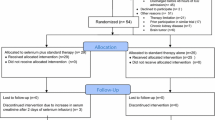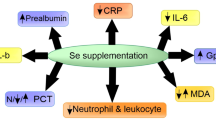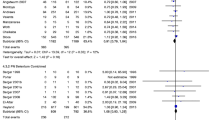Summary
□Background: It has been hypothesized that low serum selenium concentrations, associated with low glutathione peroxidase activities in critical ill patients may contribute to decreased cleavage from free radicals and deteriorate the clinical outcome.
□Patients and Methods: We therefore performed a controlled, prospective study including 42 patients with inflammatory response syndrome and an APACHE-II score≥15. Whereas the controls (Se-, n=21) received 35 µg sodium selenite during the whole treatment period the selenium substitution group (Se+, n=21) received additional 500 µg, 250 µg and 125 µg sodium selenite, each amount for 3 days. Clinical outcome was monitored by APACHE-III score, documentation of acute renal failure, respiratory insufficiency and the mortality rate until discharge from the hospital.
□Results: The mean APACHE-II(III) score on admission was 20.6 (68.3) in the Se- versus 20.1 (61.0) in the Se+ group. Age, sex, underlying diseases, the serum selenium levels and glutathione peroxidase activities on admission were equally distributed in both groups. Selenium substitution was followed by a significant increase in serum selenium levels and glutathione peroxidase activity to normal levels, whereas in controls both parameters remained low. The APACHE-III score significantly improved on day 7 (p=0.018) and 14 (p=0.041) in the Se+ group. Hemodialysis because of acute renal failure was necessary in 9 (Se-) versus 3 (Se+) patients (p<0.04). Overall mortality rate in the Se+ group was 33.5% versus 55% in the Se- group (p=0.13). A subanalysis of those patients with an APACHE-II score τ; 20 (n=10) in each group revealed a significant reduction in mortality from 70% to 30% (p=0.013). No negative side effects of selenium were seen.
□Conclusion: Selenium substitution significantly improves clinical outcome and reduces the incidence of acute renal failure.
Similar content being viewed by others
Literatur
Goode, H. F., H. C. Cowley, B. E. Walker, P. D. Howdle, N. R. Webster: Decreased antioxidant status and increased lipid peroxidation in patients with septic shock and secondary organ dysfunction. Crit. Care Med. 23 (1995), 646–651.
Goode, H. F., N. R. Webster: Free radicals and antioxidants in sepsis. Crit. Care Med. 21 (1993), 1770–1775.
Haglund, U., B. Gerdin: Oxygen-free radicals (OFR) and circulatory shock. Circulat. Shock 35 (1991), 405–411.
Harrison, I., D. Littlejohn, G. S. Fell: Distribution of selenium in human blood and serum. Analyst 121 (1996), 189–194.
Hawker, F. H., P. M. Stewart, P. J. Snitch: Effects of acute illness on selenium homeostasis. Crit. Care Med. 18 (1990), 442–446.
Hunt, D. R., H. W. Lane, D. Beesinger, K. Gallagher, R. Halligan, D. Johnston, B. J. Rowlands: Selenium depletion in burn patients. J. parent. ent. Nutr. 8 (1984), 695–699.
Knaus, W. A., E. A. Draper, D. P. Wagner, J. E. Zimmerman: APACHE-II: a severity of disease classification system. Crit. Care Med. 13 (1985), 818–829.
Knaus, W. A., D. P. Wagner, E. A. Draper, J. E. Zimmerman, M. Bergner, P. C. Bastos et al.: The APACHE-III prognostic system. Risk prediction of hospital mortality for critically ill hospitalized adults. Chest 100 (1991), 1619–1636.
Kuklinsky, B., T. Zimmermann, R. Schweder: Letalitäts-senkung der akuten Pankreatitis mit Na-Selenit: Klinische Resultate einer vierjährigen Antioxidanzientherapie. Med. Klin. 90 (1995), 36–41.
Ogilvie, A. C., A. B. J. Groneveld, J. P. Straub, L. G. Thijs: Plasma lipid peroxides and antioxidants in human septic shock. Intens. Care Med. 17 (1991), 40–44.
Peretz, A.: Selenium in inflammation and immunity. In: Neve, J., A. Favier (eds.): Selenium in medicine and biology. De Gruyter, New York 1988, p 235–246.
Prabha, P. S., U. N. Das, G. Ramesh, K. V. Kumar, V. Kamalakar: Free radical generation, lipid peroxidation and essential fatty acids in patients with septicemia. Prostaglandins Leukot. essent. fatty Acids 42 (1991), 61–65.
Robinson, M. K., J. D. Rounds, R. W. Hong, D. O. Jacobs, D. W. Wilmore: Glutathione deficiency increases organ dysfunction after hemorrhagic shock. Surgery 112 (1992), 140–149.
Thomas, J. P., M. Maiorono, F. Ursini, A. W. Girotti: Protective action of phospholipid hydroperoxide glutathione peroxidase against membrane-damaging lipid peroxidation. In situ reduction of phospholipid and cholesterol hydroperoxides. J. biol. Chem. 265: (1990), 454–461.
Urban, T., C. Jarstrand: Selenium effects on human neutrophilic granulocyte function in vitro. Immunopharm. 12 (1986), 167–172.
Wagner, D. P., W. A. Knaus, F. E. Harrell, J. E. Zimmerman, C. Watts: Daily prognostic estimates for critically ill adults in intensive care units: results from a prospective multicenter, inception cohort analysis. Crit. Care Med. 22 (1994), 1359–1372.
Weiss, S. J.: Tissue destruction by neutrophils. New Engl. J. Med. 320 (1989), 365–375.
Weitzel, F., A. Wendel: Selenoenzymes regulate the activity of leukocyte 5-lipoxygenase via peroxide tone. J. biol. Chem. 268 (1993), 6288–6292.
Xu, H., W. Mei, Z. Dong, B. Liao: Study of oxidative metabolic function and chemotaxis of neutrophils from patients with cancer influenced by selenium. Yest Biol. Trace Elem. Res. 25 (1990), 201–209.
Author information
Authors and Affiliations
Rights and permissions
About this article
Cite this article
Gärtner, R., Angstwurm, M.W.A. & Schottdorf, J. Selensubstitution bei Sepsispatienten. Med Klin 92 (Suppl 3), 12–14 (1997). https://doi.org/10.1007/BF03041951
Issue Date:
DOI: https://doi.org/10.1007/BF03041951




